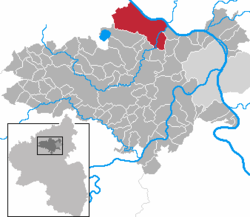Andernach
| Andernach | ||
|---|---|---|
 |
||
|
||
| Coordinates: 50°26′23″N 7°24′06″E / 50.43972°N 7.40167°ECoordinates: 50°26′23″N 7°24′06″E / 50.43972°N 7.40167°E | ||
| Country | Germany | |
| State | Rhineland-Palatinate | |
| District | Mayen-Koblenz | |
| Government | ||
| • Lord Mayor | Achim Hütten (SPD) | |
| Area | ||
| • Total | 53.23 km2 (20.55 sq mi) | |
| Population (2015-12-31) | ||
| • Total | 29,441 | |
| • Density | 550/km2 (1,400/sq mi) | |
| Time zone | CET/CEST (UTC+1/+2) | |
| Postal codes | 56626 | |
| Dialling codes | 02632 | |
| Vehicle registration | MYK | |
| Website | www.andernach.de | |
Andernach (German pronunciation: [ˈandɐˌnax]) is a town in the district of Mayen-Koblenz, in Rhineland-Palatinate, Germany, of currently about 30,000 inhabitants. It is situated towards the end of the Neuwied basin on the left bank of the Rhine between the former tiny fishing village of Fornich in the north and the mouth of the small river Nette in the southeast, just 13 miles (21 km) north of Koblenz, with its five external town districts: Kell, Miesenheim, Eich, Namedy, and Bad Tönisstein. A few hundred metres downstream of Andernach the Rhine valley narrows from both sides forming the northern part of the romantic Middle Rhine stretch. Already in Roman times the place the narrow passage begins was named "Porta Antunnacensis" or Andernachian Gate. It is formed by two hills, the Krahnenberg (engl. Crane hill) and the Engwetter (Narrow weather) on the right bank near the wine village Leutesdorf (external town district of Bad Hönningen). The crane hill is named after the old crane beneath his foot (see below); in earlier times (until 1650) the hill was named "Geiersberg" ("Vulture's hill").
The coat of arms of Andernach known since 1344 (the colours appeared first in 1483) shows a black cross on a white escutcheon (shield) charged with a pair of X-shapedly arranged red keys. It is described in heraldic language as Argent a cross sable charged with keys in saltire gules.
The black cross on silver symbolizes the governance of the Electorate of Cologne; the keys refer to St. Peter the patron saint of the Archbishopric of Trier (and of the cathedral of Trier), of which Andernach formed part. The red (key) colour adverts to the red cross (on silver) in the coat of arms of the Electorate of Trier.
The oldest town seal shows St. Mary sitting on a throne with a church in her right hand and with the left hand holding a town. The seal inscription says: MATER DEI PATRONA CIVIUM ANDERNACENSIUM - Mother of God, patron saint of the Andernachian citizens. The oldest seal was made before 1200, the oldest seal impression dates from the year 1250.
...
Wikipedia



